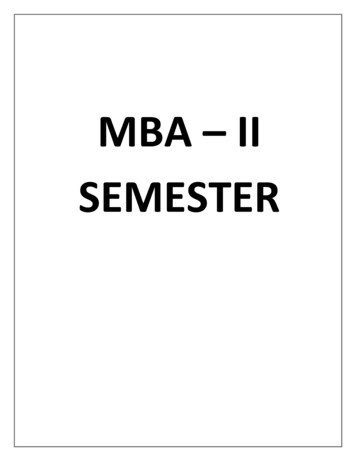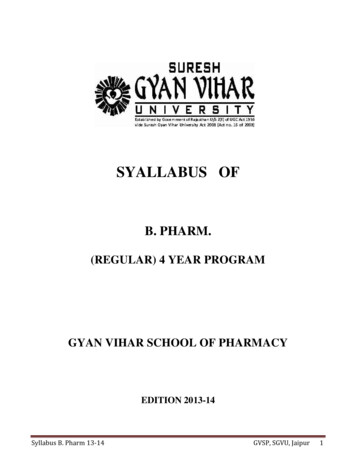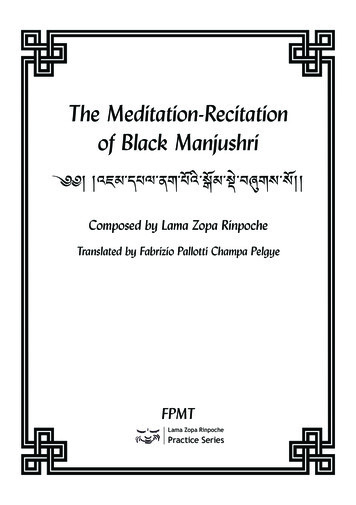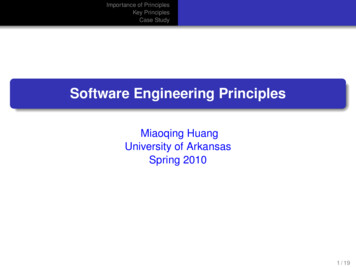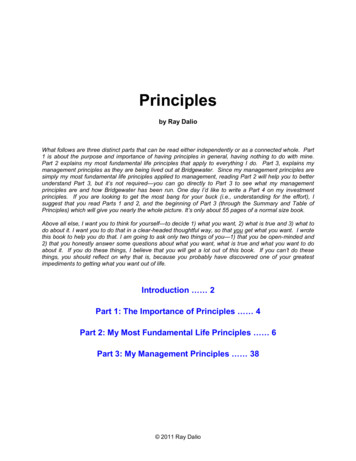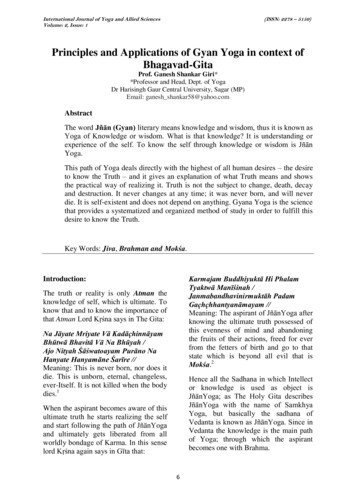
Transcription
International Journal of Yoga and Allied SciencesVolume: 2, Issue: 1(ISSN: 2278 – 5159)Principles and Applications of Gyan Yoga in context ofBhagavad-GitaProf. Ganesh Shankar Giri**Professor and Head, Dept. of YogaDr Harisingh Gaur Central University, Sagar (MP)Email: ganesh shankar58@yahoo.comAbstracthThe wordhhhhhhYoga.This path of Yoga deals directly with the highest of all human desires – the desireto know the Truth – and it gives an explanation of what Truth means and showsthe practical way of realizing it. Truth is not the subject to change, death, decayand destruction. It never changes at any time; it was never born, and will neverdie. It is self-existent and does not depend on anything. Gyana Yoga is the sciencethat provides a systematized and organized method of study in order to fulfill thisdesire to know the Truth.Key Words: Jiva, Brahman and Mokśa.a aja Buuk H P alaT ak w Ma īś a /Janmabandhavini ukPa aaa aa a //hknowing the ultimate truth possessed ofthis evenness of mind and abandoningthe fruits of their actions, freed for everfrom the fetters of birth and go to thatstate which is beyond all evil that isMokśa.2Introduction:The truth or reality is only Atman theknowledge of self, which is ultimate. Toknow that and to know the importance ofthat Atmanhaa M aaaB ū w B avaB ū a /Ajoa Ś śwa oa a Pu o aHa a Ha aŚa ī //Meaning: This is never born, nor does itdie. This is unborn, eternal, changeless,ever-Itself. It is not killed when the bodydies.1hhh hhh hWhen the aspirant becomes aware of thisultimate tru h hhhhhhhVedanta the knowledge is the main pathof Yoga; through which the aspirantbecomes one with Brahma.hh6
International Journal of Yoga and Allied SciencesVolume: 2, Issue: 1(ISSN: 2278 – 5159)hthe Atman is A a a śwa ūpa (asblissful)śwa ūpa (knowledgeform), Sat (truth), Nitya (forever),Suddha (pure) and Buddha (intellect). Inthe real sense the Atman is Brahma itself. Only Brahman is the reality, there isno existence except it.influenced by the three gunas (the basicqualities or constituents of prakrti ornature).Intamasa-jnanatheunderstanding is of the nature of dullnessand indifference and clings to a singleaspect of the phenomenal world as if itwere the whole of reality. In rajasa-jnanathe understanding is moved by passionand activity in perceiving a world ofmultiplicity without a sense of anunderlying unity. Finally in sattvik-jnanathe understanding is illumined by theknowledge that there is but oneimmutableReality.Whentheunderstanding or intelligence (buddhi)remains stable in sattvik-jnana, yoga isattained.Brahman is self-focused, endless,uninterrupted, unborn, conscious andblissful. As the fire is one and reflects indifferent form in several places, the sameis the case with Brahman, it is one butappears in the form of soul of everycreatures and it is beyond all of them.Accordinghof unity of Jiva (the individual being)and Brahman (the Supreme Being),hhthe liberation. In other words theknowledge of Brahman and liberationhAccording to this tradition it is possibleonly when the oneness of Jiva andBrahman has been proved. It has beensaid that the aspirant of higher levelbecomes able to know that reality onlythrough listening the Srutivakya (thesayings of Brahman). He becomes ableto remove the difference between Jivaand Brahman. According to Vedanta thisreality is possible only throughKnowledge.3Śrutivipratipann te yad sth syatiniścal sam dh v acal buddhis tad yogamav psyasi Meaning: When your intelligence standsunshaken and stable in spirit samadhi,then will you attain insight yoga.4prajah ti yad k m n sarv n p rthamanogat n tmany ev tman tuś ah sthitapragyastadocyate Meaning: When a man puts away all thedesirehO’, and whenhis spirit is content in itself, then is hecalled stable in intelligence.5duhkheśv anudvignaman śukheśuvigatasp hah v tar gabhayakrodhah sthitadh rmunir ucyate Meaning: He whose mind is untroubledin the midst of sorrows and is free fromeager desire amid pleasures, he fromwhom passion, fear, and rage havepassed away, he is called a sage ofsettled intelligence.6The compound jnana-yoga first appearsin the Bhagavad-Gita, where along withbhakti- and karma-yoga, it forms part ofa comprehensive threefold spiritualdiscipline.The Gita praises jnana or wisdom forbeing the great purifier which helps us tocross the sea of ignorance that keeps usin bondage (see verses IV. 35-38). Thispurification takes the form of anevolution of the understanding orintelligencewhichisvariouslyyah sarvatr nabhisnehas tat tat pr pyaśubh śubham 7
International Journal of Yoga and Allied SciencesVolume: 2, Issue: 1(ISSN: 2278 – 5159)though jnana-yoga is generally held to bean important aid to liberation, theisticdevelopments in some schools ofVedanta regard bhakti or devotion to theLord as the most effective means.However in Advaita Vedanta, whichbecame the dominant philosophicalposition with the decline of Buddhism inIndia towards the end of the firstmillennium CE, jnana-yoga is consideredto be sole means to moksa.9n bhinandati na dveśti tasya pragypratiś hit Meaning: He who is without affection onany side, who does not rejoice or loatheas he obtains good or evil, hisintelligence is firmly set in wisdom.7yad saśharate c yaś k rmo 'Çg n vasarvaśah indriy nindriy rthebhyas tasya pragypratiś hit Meaning: He who draws away the sensesfrom the objects of sense on every sideas a tortoise draws in his limbs [into theshell], his intelligence is firmly set inwisdom.8htwo paths: Antaranga practice andBahairangapractice.Bahiranga(external) practice includes Viveka,a ag a Śa śa pa and Mu ukśu va;whereas the Antaranga (internal)practice includes Sravana, Manana andNidhidhyasana.As a spiritual discipline, jnana is alsocentral to the philosophical traditions ofSamkhya and Vedanta. Samkhyadoctrines can be found in the BhagavadGita, and form the basis of thehP’-sutras.In both the Samkhya and Yoga darsanas,discrimination between the products ofprakrti (nature) and purusa (pureconsciousness) leads to liberation(kaivalya).However where Patanjali recommendspractices that advance from dharana(concentration)thoughdhyana(meditation) to samadhi in order to aidthe development of this discrimination,Samkhya relies on the refinement r has to develop and cultivatethe ability to recognize what isimpermanent, temporary and fleeting inlife as the Sadhaka experiences the fact what is of everlasting value and pointingto the eternal. The practitioner becomesable to discriminate the superficial andthe essential; as well as the illusoryreality on the surface and the absolutereality in the inner, deep dimension ofexistence. In this way the person tries toscrutinize,analyzeandevaluateconstantly the experiences, inclinations,decisions and actions.Both Sankya and Vedanta argue thatwhat binds us to the cycle of birth, deathand rebirth is avidya (ignorance), andthey look to knowledge to dispel it. Inthe Samkhya tradition this is soughtthroughreasonbecausethediscriminative intellect (buddhi) is takento be the first evolute of prakrti, and so ithas precedence over all the otherelements of nature. In Vedanta thesituation is not so straightforward. EvenVairagya (dispassion): In the practice ofVairagya the practitioner has to guard hismind against becoming possessed,infatuated and even slightly disturbed bypassions springing from the sensualdesires. Later on he has to stop all thedisturbances like attachment to thingsthat bring sensual satisfaction. Theopposite of Vairagya is Raga (passion)which means originally coloring, whichindicates that passions are, in fact8
International Journal of Yoga and Allied SciencesVolume: 2, Issue: 1(ISSN: 2278 – 5159)obstructions of the mind which do notallow clear vision. To achieve the clarityof mind (which is essential for finalknowledge and wisdom) attachments andpassions must be avoided and abolished.to the mind of the aspirant the rightdirection and outlook and material forthe second stages which is Manana.Manana starts with intellectual analysisof the material gained by studying thetexts. The analysis of the material gainedby knowledge of the world of sensualand emotional experience and on thelevel of speculative thinking, finalknowledge cannot be found. Absolutetruth can lie only beyond them. When thepractitioner firmly arrives at thisconclusion, he is able to enter the path ofmeditation which brings him to thefollowing and final stage of trainingwhich is Nidhisyasana.Satsampati (Six - attainments): Thisdiscipline includes a six fold instructionof self - education for success on the pathof Yoga which are: Sama: Thecultivationtranquility of the mind. Dama: Self control in action Uparati: Means eradicatingeagerness to possess. Titikśa: To have patience Sraddha: Confidence (inmeaning of faith). Samadhana: Intentness ofmind.ofthetheThis expression can be translated asconstant meditation. This stage oftraining makes it clear to the Sadhakathat the process of opening a newchannel to reality over and above thesenses and the intellect is not a matter ofmental exercises during meditationalsession only, but that it is also andequally necessary to introduce a kind of’that eventually the mind is in a state ofmeditation even when dealing with thebusiness of everyday life. As thiscapacity is developed and deepened, the’until he reaches the final vision of truth,which brings the aspirant at the finalachievement of liberation or Mokśa.theMumuksutva (longing for liberation):This fourth Sadhana of Vedanta is veryimportant. It should be understood as theintense desire to get the higher level ofconsciousness i.e. Samadhi. The Sadhakaor aspirant should develop a positivedesire for liberation. Its development issupported by the previous endeavors asthe advanced ability to discriminate theunsatisfactory superficial reality and thesafety-promising, spiritual dimension ofhigher experience. The practice leadstowards ultimate reality i.e. Brahman.hthe first one is Sravana which meanshearing. The practitioner has to go firstthrough an extensive and intensive study,for which one should go to his Guru (thespiritual teacher or master) and shouldlisten to the lesson on (about) Brahman.In ancient time it was done in Ashrams(the traditional school of Vedanta orYoga), now a days it includes thoroughstudies of the traditional doctrines of theUhThe only way to attain absoluteliberation is when jnana is transformedinto jnana yoga. Krishna clarifies thispoint in the Bhagavad Gita as:brahmabhūtah prasann tm na śocatina k kśati samah sarveśu bh teśu madbhaktihlabhate par m 9
International Journal of Yoga and Allied SciencesVolume: 2, Issue: 1(ISSN: 2278 – 5159)Meaning: In the state of atma-jnana orself realization (called brahm-bhoot) ajnani is impartial to all. He has nomaterial desire and experiences no painon being separated from any materialobject or person, yet he has not attaineddivine knowledge of God (brahmjnana). Because of this he can still fallfrom his spiritual height.10Me and attain divine realization. Heattains the full knowledge of what wasonly partially understood.11Conclusion:Jnana yoga is the path of wisdom,knowledge, and direct experienceof Brahman as the ultimate reality. Thepath renounces both desires and actions,and is therefore depicted as being steepand very difficult in the Bhagavad Gita.This path is often associated with thenon-dualistic Vedantic belief of theidentity of the Ātman with the Brahman.For the followers of this path, therealisationoftheidentityof Ātman and Brahman is held as the keyto liberation.Krishna explains the atma jnani securesand perfects this knowledge only throughbhakti (devotion) and grace as:bhakty m m abhij n ti y v n yaśc smi tattvatah tato m m tattvato gy tv viśatetadanantaram Meaning: Only through bhakti to Me andwith My Grace does an atma jnani /51Kumar K. (2012) Yoga Education A text Book; Shipra Publications Śh18/5510
position with the decline of Buddhism in India towards the end of the first millennium CE, jnana-yoga is considered to be sole means to moksa.9 h two paths: Antaranga practice and Bahairanga practice. Bahiranga (external) practice includes Viveka, a ag a Śa śa a and Mu ukśu va;

